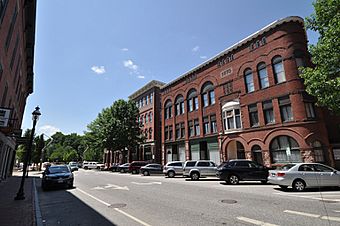Auburn Commercial Historic District facts for kids
Quick facts for kids |
|
|
Auburn Commercial Historic District
|
|

View of the commercial section of Main Street
|
|
| Location | Auburn, Maine |
|---|---|
| Area | 2.43 acres (0.98 ha) |
| Architect | Multiple |
| Architectural style | Late Victorian; Colonial Revival |
| NRHP reference No. | 14001087 |
| Added to NRHP | December 29, 2014 |
The Auburn Commercial Historic District is a special area in Auburn, Maine. It includes twelve important buildings from the late 1800s. These buildings show how the city grew between 1855 and 1902. They were once home to many businesses, offices, and social clubs. The city's main offices were also located here. This historic district was added to the National Register of Historic Places in 2014. This means it is recognized as a very important place in American history.
Exploring Auburn's Historic Downtown
Auburn started as a small camp for people who floated logs down the Androscoggin River. In the 1800s, it didn't grow as fast as its neighbor, Lewiston. Lewiston had better spots for big textile factories. But things started to change for Auburn.
How Auburn Grew
- 1822-1823: A bridge was built across the river. This helped new buildings appear along the roads that are now Main and Court Streets.
- 1848: The railroad arrived in Auburn. This made it easier to bring goods and people to the city.
- 1854: Auburn was chosen to be the main city, or "county seat," for the new Androscoggin County. This made the area even more important.
Key Streets and Buildings
Court Street in Auburn is a continuation of Lewiston's Main Street. It gets its name from the Androscoggin County Courthouse and Jail. This building is a few blocks west of the bridge. The historic district is on the south side of Court Street, stretching from High Street to Main Street.
Main Street runs next to the river. The block between Court and Drummond Streets has many old buildings from the 1800s. Two important buildings here are Auburn's old and new city halls. The older one, called Auburn Hall, was built in 1865. It was designed by a famous architect named Gridley James Fox Bryant. The city's current offices are just north of Auburn Hall on Court Street. This newer building was built in 2004. It was designed to look similar to the older buildings around it.



